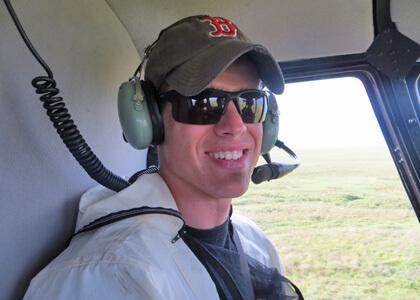Coming into UVM I decided to pursue environmental science in the Rubenstein School realizing that the major would likely provide me ample field and laboratory experience. However, I never imagined that it would provide me with the experience I had this past summer.
Under Dr. William ‘Breck’ Bowden, I worked as an assistant lab technician. For the first half of the summer, I remained in Burlington, running experiments and analyzing water samples within the Rubenstein Ecosystem Science Laboratory. For the second half of the summer I traveled to the remote Toolik Field Station in northern Alaska where I mostly helped with field work and provided laboratory assistance for the Changing Seasonality in Arctic Stream Networks (CSASN) project.
Professor Bowden is a biogeochemist and his current research deals with studying nutrient (primarily carbon, nitrogen, phosphate) cycling dynamics in arctic stream networks. More specifically, the CSASN project looks into how these dynamics change on a seasonal basis and are connected to the surrounding landscape.
Characterizing the cycling of carbon, nitrogen, and phosphate in arctic stream networks will help further the understanding of arctic ecology as a whole. The implications of a warming climate and its ecological effects on the arctic elevate the importance of this work.
At the lab in Burlington, I had the privilege to work with some incredibly dedicated lab technicians, graduate students, and researchers. My duties varied, but they mainly dealt with the research being executed in Alaska. There were many days spent running water samples collected from previous arctic field seasons for different nutrients and their various forms.
However, this was not my only task and I had several opportunities to help with other projects. I remember one particularly warm and sunny day spent out on the Lab’s research vessel, the Melosira, installing a new water quality monitoring buoy out in Missisquoi Bay. Subsequently, I had the responsibility of maintaining and recalibrating the monitor’s probes on a regular basis.
After a great month and a half in Burlington, I flew into Fairbanks, Alaska, met up with my lab team, and drove 10 hours north up the Dalton Highway to the Toolik Field Station. Six days a week and upwards of 12 hours a day (24 hour sunlight works better than coffee) were spent in the field and in the lab. It was a lot of work, but it was very rewarding.
Whether it was spending a full day cruising the tundra in a helicopter to collect distant samples, wading through a river to record benthic algal composition, or simply filtering water samples, I was constantly learning and acquiring new skills. Additional attractions, such as a surprisingly good dining hall, a sauna, and a close-knit community of scientists, helped make my time at Toolik an unforgettable experience.
I learned a lot from this summer experience, including everything from how to digest a chlorophyll-a sample to how to fly-fish. Most importantly, I learned that science does not only need to take place in a lab, but that it can provide you with the outdoor adventure of a lifetime.
To offer some advice, I want to stress that advertised internships are hardly the only opportunities out there. Simply asking a professor if they know of any summer jobs can go a very long way. If you travel somewhere exotic for an internship, make time before or after it to explore the region and go off the beaten path. And finally, if you are offered a job in Alaska, go for it!
For my upcoming summer plans, I will be travelling back to Alaska and the Toolik Field Station to work under the "Scale, Consumers and Lotic Ecosystem Rates" (SCALER) project.
